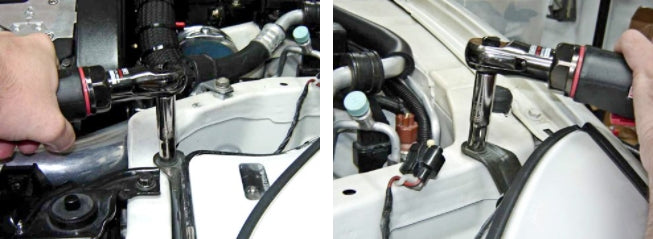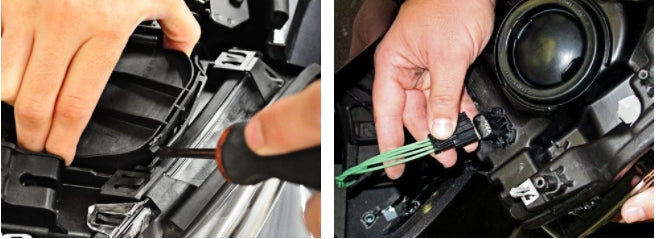How to install a set of custom headlamp assemblies
If the front of a vehicle is its "face," headlamps have long been considered the vehicle's "eyes." Everyone notices them. One of the most distinctive modifications you can make to the surface of your car or truck is replacing the factory headlamp assembly with a custom set. Your vehicle will take on a personality of its own and acquire a unique look that sets it apart from all other similar vehicles on the road.
Our custom headlamps are sold in pairs, designed to fit into exact locations on the factory unit, and are less expensive than you might think. For the scope of this article, we only sell complete headlamps designed for your specific vehicle. A step-by-step guide to the basics of installing a custom headlight unit. The xenon headlamp assembly requires additional high-voltage equipment and control modules, so we omitted it.
before you start
For new parts, headlights, etc., it's always a "best practice" to start by unpacking the components and making sure everything is in good condition. Unpack the new headlamp assembly and inspect it for any physical damage.
If your headlights have single wires for DRL or halo lights, connect these wires (red or white usually positive, black usually negative) to a 12 volt power source, such as your car battery, and all lights will work. I will try to do that.
Bumper cover removal and installation (if required)
Tools required: Open-end wrench, socket wrench, rivet gun (for specific vehicle applications), screwdriver, Torx head bit (if applicable), power drill (if applicable)

This is the first step, as many modern vehicles require you to slide the plastic front bumper cover an inch or so or remove it completely to access the anchor points where the headlight assemblies are bolted to. It is often a step. If you are unsure whether this step is necessary, we recommend checking with your vehicle manufacturer or accessing your repair manual online. Removing and reinstalling front bumper covers is relatively easy, as most are designed to unbolt and slide out with basic hand tools.
If you look closely at your bumper cover, you'll notice that the bolts that hold it in place are usually exposed when you open the hood. They can also be found under the vehicle where the bumper cover meets the splash shield and near the edge of the wheel well opening where the wheel well liner meets the fender. There may also be a small plastic cap or clip covering such a bolt, remove it with a small flathead screwdriver.
Remove the bolt itself with the appropriate socket wrench or slotted wrench. If your car manufacturer uses rivets to hold things together (in the wheel well area), you'll need to drill the holes with a traditional drill. Next, you'll need a rivet gun to reinstall the new one. It's not an expensive purchase, but it's a good tool to use. When drilling rivets, bits designed for drilling into metal are best because they have a higher heat rating.
Once all fasteners are removed, the bumper cover can be removed. Many are designed to slide horizontally along a special bracket piece mounted below before loosening completely, so if you can't get specific instructions for your make and model, start with this Move the bumper cover in a way.
Unbolt the old headlamp assembly
Tools needed: socket wrench, screwdriver

Depending on the year and model of your vehicle, you may need to remove the front grille section of your vehicle to access the bolts or clips that secure the headlight assembly in place. To do this, remove the screws from the top or side of the grille, or remove the retaining clip on some vehicles with a flathead screwdriver.

Remove the bolts after removing the grille, trim, and bumper cover sections to access the mounting points for the headlamp assembly. A small socket wrench is usually best for this kind of application. Locate the metal body panel retaining bolts on the top and sides of the headlamp assembly. Some vehicles have a hold down clip on the headlamp assembly that can be removed with a flathead screwdriver.

Once all applicable retaining bolts and clips have been removed, slide the old headlamp assembly out of the vehicle. Note that the electrical wiring harness is still attached unless you later remove it from the back. Do not remove the bulb from the factory housing yet. Set aside your OEM headlamp assemblies in case you want to reinstall them one day, for example, if you decide to sell your vehicle.
Removing and reconnecting electrical wiring
Tools needed: wire stripping tool, wire connectors, pliers (if applicable), electrical tape.
Once you've pulled the old headlamp assembly away from the vehicle, take a closer look at the wiring harness it's attached to. Even if you removed one or more connectors from the back of the assembly before removing the bolts, other previously hidden connectors may still be attached (such as another wire to the side marker bulb). Once everything is visible, disconnect all electrical connectors from the back of the headlight assembly. Typically, simply squeezing the end of the connector or pulling up on the tab will release the connector, but if a thin wire bar is present, you usually need to slide it into the unlocked position first. If you're not sure how the locking clip is designed to release, we recommend further researching the instructions for your make and model.
You are now ready to start installing your new lights. Make all electrical connections first while accessing the back of the assembly. After that, we will mechanically attach it to the front of the vehicle.
Moving light bulbs from old assembly to new assembly
Depending on the year and model of your car, and the design of your new custom lights, you may need to replace the bulbs. New lights typically include low/high beam headlight bulbs. Turn signal (incandescent) bulbs are often not included in new assemblies. This is very easy to fix. You will need to remove the signal bulb from the old lamp (do not remove the wires) and install it on the new lamp in the existing housing. There may be paper stickers that need to be removed first.
Plug and play part of installation
Both old and new headlamps have low beam headlamps and high beam headlamps. When you removed your old unit, you disconnected the electrical plug from your car or truck's wiring harness. The new assembly has an electrical plug that is exactly the same shape as the plug in the old assembly. This part of the electrical installation is called "plug and play". Because you literally just need to connect a new plug to your existing harness. If you purchased the lamp without additional lighting elements such as a halo or LED lights, the electrical installation is complete.
Connecting extra wires on Halo and LED custom headlamp assemblies
If you install a custom headlamp assembly with additional halos or LED lights ("bonus lights"), you'll find additional sets of wires. In a typical installation, there is one set of wires for each additional light. Within each pair, one wire is "positive" (usually red or white) and the other is "negative" (usually black). Assuming you want the LEDs and halos to light up in your headlights, you'll be splicing both white wires and both black wires together.
However, if you want these lights to be triggered by your vehicle's daytime running lights (DRLs), parking lights, or turn signals, you can connect the wires to those items' separate power wires instead. Masu. For example, if they are wired into a DRL harness, they will be visible to the world whenever the DRL is turned on during the day. Or you can show them off by connecting them to the parking light wires when you're parked on the street on cruise night (they'll flash every time you use keyless entry). Wiring harnesses for various lighting functions vary from vehicle to vehicle, so we recommend researching location and wire color for your specific make and model. Inspect the factory harness using a test light or multimeter (DMM, or digital multimeter). Be sure to turn on the lights for the circuit you are pursuing so it appears as "live".
Once you have determined which wires to connect, use the wire stripping tool (available in the Wire & Cable Tools section) to remove 1 inch of colored insulation from the end of each wire. The "power" wire must be connected to the lighting circuit. The "negative" or "earth" wire can be connected to any convenient vehicle ground point. However, if you choose to splice your wires permanently, you can still find all the odds and ends you need: butt connectors, quick splice connectors, and crimp caps. ) can be found in the Connectors and Terminals section of our website.
Before bolting a new headlight assembly to your vehicle, check the back of the assembly to see what type of knobs, screws, or fittings are present for the purpose of adjusting headlight aiming. Look for suitable hand tools that provide grip and set them aside. Test all lights and turn signals to ensure they are working properly. Once that is confirmed, tighten the new headlight assembly securely into place and reinstall all other components in the reverse order of removal.
Adjusting the headlight aim after installation
Necessary tools: tape measure, masking tape
The knobs, screws, and hardware on the back of the headlamp assembly that adjust the headlight's aim vertically and horizontally vary widely depending on the design. Once you have the tools you need to turn a particular adjustment knob on the headlamp assembly, also grab a roll of masking tape and a 25-foot tape measure. We will help you aim your new headlights without complex or technical equipment.
To do this, find a white wall and a flat surface to park on. This can be done indoors or outdoors, but the ground must be level and the walls flat and vertical. Measure carefully and mark exactly 3.5 feet above the bottom of the wall. Make two marks and run the masking tape horizontally through the two marks. The width of the tape should be the width of the vehicle plus 2 feet on each side.
Park your car so that the wall to headlamp plane is exactly 25 feet. Begin adjusting the low beam using the adjuster on the back of the headlight assembly so that the beam illuminates the wall 3.5 feet high.
Although we consider installing a set of custom headlamp assemblies to be "DIY," this type of work is not for everyone. If you have experience working on your own cars, you may be comfortable performing this task yourself. If you're new to the hobby and want to give this a try, use this article as a guide. You can also search the Internet for additional information. If you are unsure about tackling this for any reason, please seek professional help. Whichever path you choose, have fun with your project and enjoy your new custom lights on your ride!











Leave a comment
All blog comments are checked prior to publishing